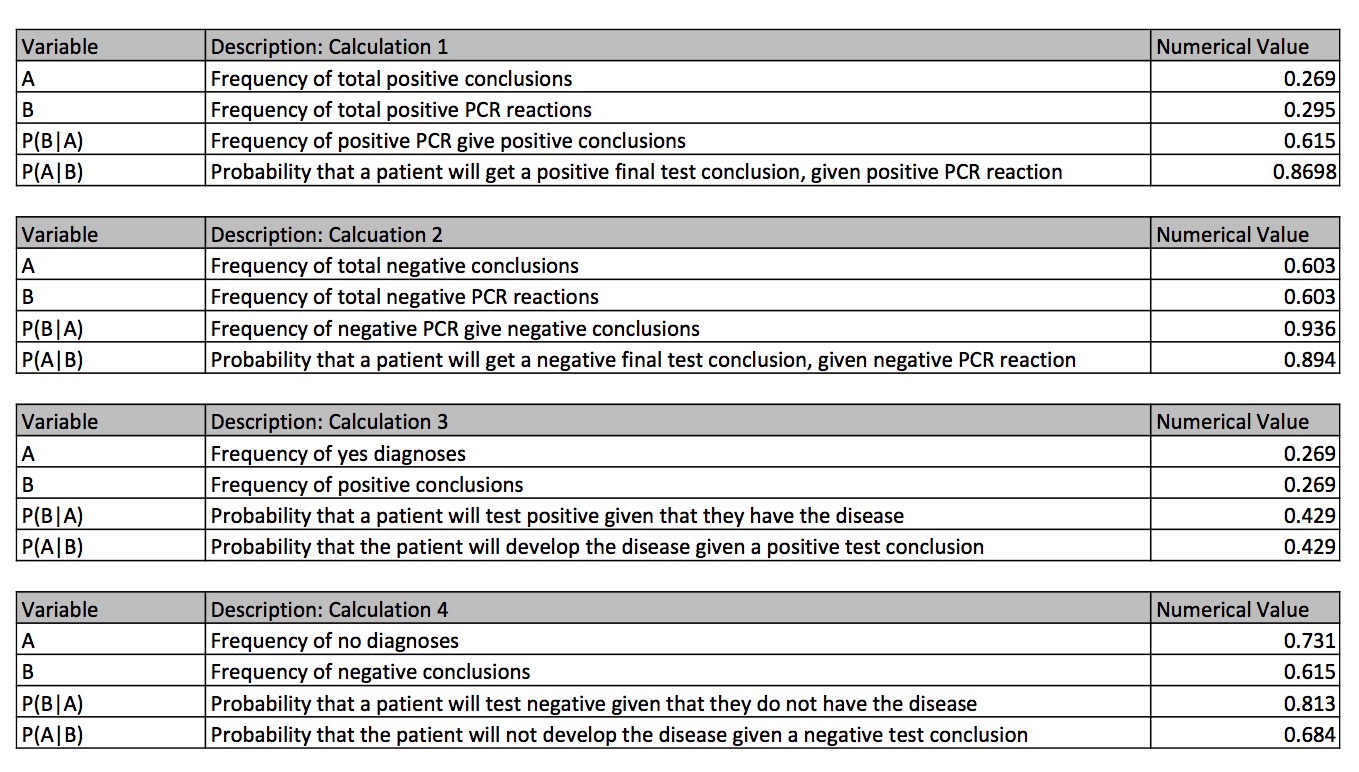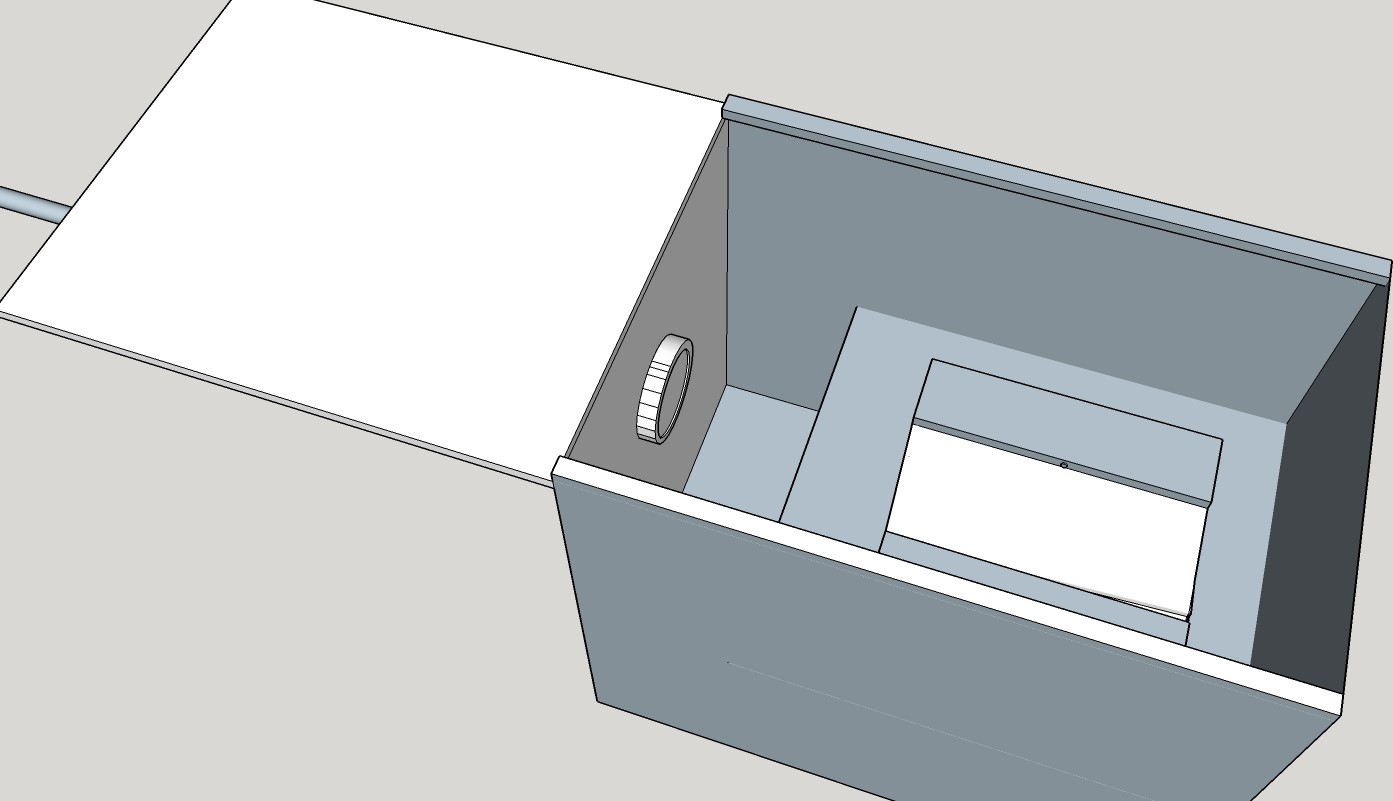BME100 f2016:Group15 W1030AM L6
| Home People Lab Write-Up 1 | Lab Write-Up 2 | Lab Write-Up 3 Lab Write-Up 4 | Lab Write-Up 5 | Lab Write-Up 6 Course Logistics For Instructors Photos Wiki Editing Help | |||||||
|
OUR COMPANY
EZ Diagnostics LAB 6 WRITE-UPBayesian StatisticsOverview of the Original Diagnosis System For this experiment, there were 15 teams of around 4-5 people working on 30 different patients. Each team was assigned to work with 2 different patients and were expected to find out if the patient tested positive or negative for the disease. Due to the larger scale of the experiment, it is more likely that sources of human error would occur, due to amount of people working on the same project simultaneously. Some other sources of error could have come from not properly sealing the containers before running it through the tests, or improper pipetting could have played a part in there not being enough of a sample to analyze. The angle at which the picture was taken also affected the ImageJ processing, so this may have altered results very slightly, so a patient may be misdiagnosed. To prevent this, there were some measures taken to minimize these mistakes, such as video tutorials on proper pipetting technique as well as instructor assistance. These measures that were taken decreased the chances of some things occurring unexpectedly or the slight altering of the results. Unfortunately, there is not much that can be done about taking the image at the right angle to optimize imageJ processing of looking for green dye, but in general, it was fairly accurate at determining the right amount of sample in the given area. What Bayes Statistics Imply about This Diagnostic Approach Calculation one shows that the chances a patient will test positive, given a positive test conclusion are fairly high, averaging at around the value 0.87 or 87%. Calculation two shows that the probability that a patient will test negative given a negative test conclusion is fairly high as well, with this value being at around 0.89 or 89%. Calculation three shows the accuracy of being tested positive and actually having the disease is fairly low, with a value of 0.43 or 43%. Calculation four had a value of 0.68 or around 68% for the accuracy for not having the disease when being tested as negative by the process. One source of error may have been putting the wrong amounts of a substance into the test tube, so results would be skewed and inaccurate. Another source of error that may have occurred is mechanical error. The PCR machine may have ben set to the wrong setting and this results in the sample having too little DNA to detect by camera. One final source of error that may have happened was with handling and mixing the samples. It was a little busy with all of the different chemicals in one spot, so chemicals may have easily been mixed incorrectly without paying proper attention or care.
Intro to Computer-Aided Design3D Modeling Our Design Our group took the original fluorimeter design in lab and made it more compact. Our product is portable, and much easier to transport with its simple cubic design. It is also very convenient to use, as the design includes a digital camera that hooks straight up to your computer with it's USB. The device's top opens in a sliding motion to expose the slide where the drops are placed with easy access. What is not seen in the picture above is the switch that turns on the blue light that shoots across the slide to display the green color found in the pictures. With our design there is no need to worry about phone alignment or the process of sending the pictures to the computer to be calculated. With the USB connection the camera will be able to use the poser of the computer to take pictures, these pictures then will be taken on the computer and saved straight into your Files. The fluorimeter in lab was bulky and time consuming with it bulk movements to expose the inside of the box to change solutions and also repositioning the camera took a lot of time too. Our Device helps eliminate the hassle and speed up the calculation process.
Feature 1: ConsumablesMany of the consumables used in the labs including: the reagents, plastic tubes, pipette tips, will not be included in our kit as we are just improving on the fluorimeter not the PCR machine, these consumables will need to be purchased separately for experiments. Our kit comes with 4 custom slides that fit within our Fluorimeter. They are easily removable as the slide lays flat, perfectly between the two grooves, and just below the placement of the blue light. More replacement slides can be purchased from our company if the slides are broken or loss. They are made of glass and should be handled carefully, we do not supply a warranty on the slides. The fluorimeter device does includes a 2 year warranty if something is to malfunction, like the camera or blue light. Feature 2: Hardware - PCR Machine & FluorimeterPCR Machine The PCR machine will not be altered in our product, but it will still be necessary for making and handling our sample. Our device will use the samples made from the PCR machine and it will still be transferred over via micropipette, much like the traditional fluorometer. The general process will be the same for this particular device.
Fluorimeter The fluorimeter will be the primary thing being changed with the introduction of our product. There were some key issues that lead up to us developing new ideas to alter the fluorimeter. There were some inconveniences with placing the drops into the fluorimeter and it being a fairly bulk device. there were also some problems with sending and sorting out the files from the phone to the computer. Another issue was having to focus the camera before every trial and adjusting it from the outside. Our new system will address these problems in several ways. This newer fluorimeter will be more compact and there will be a sliding door to make placing samples into the correct place easier for the user. There will also be a direct usb cable to a computer to directly send files over without the hassle of trying to move them from one place to the other, making work more convenient. This direct connection will also allow the person to see the sample in real time from the computer, so the person will be able to adjust the camera easily to center it on the drop.
| |||||||






